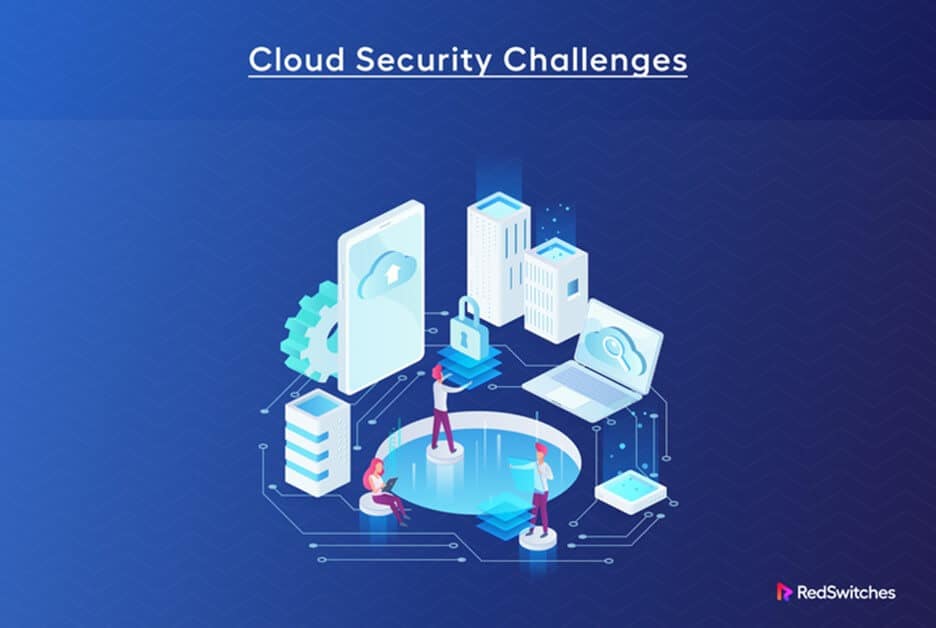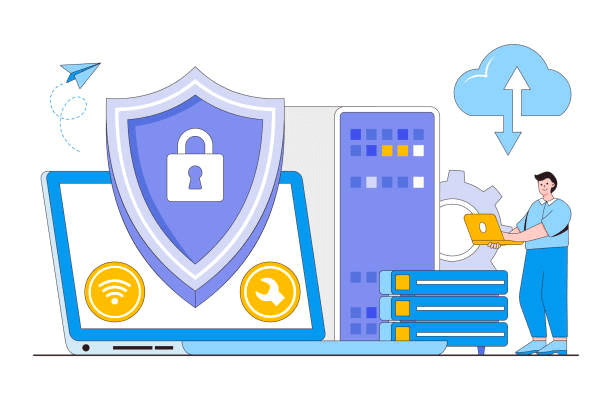A recent study shows nearly 58% of businesses use cloud services. A considerable percentage shows how cloud computing is changing the business landscape. The cloud has become an essential component of modern business, enabling them to manage their apps and data from any gadget worldwide, offering benefits like cost efficiency and flexibility. However, cloud computing has its cloud security challenges.
Businesses now face cloud computing and security challenges like service disruption and data breaches that endanger their sensitive data. It raises two essential questions: What are the best tools and practices for cloud security management? How can businesses safeguard their cloud systems from human errors and cyber threats?
In this guide, we will explore the common challenges that cloud computing security businesses face and how they can conquer them. We’ll also give tips on boosting your cloud system to meet your business goals and thrive.
Table of Content
- What Are The Cloud Security Challenges?
- What Are The Cloud Security Controls?
- How To Handle Cloud Security Threats?
- Key Takeaways
- FAQs
What Are The Cloud Security Challenges?
Any business needs to understand the top security challenges they can face. Common cloud computing and security challenges include:
1. Availability and Reliability
It refers to the capability of the cloud to perform without any interruption. These two features are crucial in ensuring customer satisfaction and confidence. However, accomplishing them is difficult because of the distributed nature of the cloud. It initiates complexity in the platform, which makes it vulnerable to cyber-attacks. Users can manage this challenge by auditing the performance of the service and server scaling, among others.
2. Security and Privacy
There are many challenges that the cloud faces, one being ensuring data security and privacy. Customers entrust their service providers to safeguard their data from any cyber threat. However, online threats are lurking everywhere, from hackers to competitors who can leak and compromise data. A provider can manage this challenge through data encryption, access verification, and more.
3. Interoperability
Different systems or apps can connect and communicate in an organized way. Ensuring interoperability between multiple platforms that service providers and users use can be challenging.
It can happen because of a lack of standard protocols, such as clashing interfaces that inhibit integration between different platforms and cloud services. Ways service providers can manage this challenge through the adoption of open APIs. It can allow flawless exchange of data between various cloud environments.
4. Performance
When a user contracts with a service provider, some of the things they expect from them is high performance. Given the cloud’s flexibility and distributed model, many variables, such as storage limitations or network latency, can affect its performance. So, to manage this challenge, users are responsible for observing and optimizing the cloud performance through server scaling or caching.
5. Portability
Migrating data from one cloud service to the other without losing quality is portability. However, customers face challenges moving their data from one provider to another. It happens because of vendor lock-in, where service providers use systems or APIs that make migrating expensive. Service providers can manage these cloud security challenges using standard APIs or systems. It allows customers to have easy data migration to a provider of their choice.
6. Unmanaged Surface Attack
When your environment gets exposed, it’s called an attack surface. It happens when you continuously add microservices to your caseload. Not only that, small data leaks can build up to a full-blown attack. A user can manage the attack surface by closely managing their cloud resources.
7. Human Error
Most cloud failures are because of some human error. It is a constant risk, especially when building business apps. It gets amplified when these business apps get hosted in a public cloud. The reason is the ease of use by multiple users without proper controls. Ways you can manage this challenge is by building strong controls.
8. Misconfiguration
Misconfigurations happen because users hop from one provider to the next. Since each provider uses different configurations, the service will have a unique implementation.
9. Data Breach
When sensitive data leaves your custody without approval, it’s a breach. Often it happens when your cloud system lacks runtime safeguards, which leaves it open to hacking. A data breach can have severe impacts on any user. For example, hackers can damage a business image by revealing company emails or sensitive data.
It can have a negative effect on customer trust and investors. Ways organizations can manage data breaches is through regular assessment tests of the system and by adding protection measures like encryption.
10. Lack of Cloud Security and Skills
The cloud needs more advanced security protocols than on-premise servers. That’s why an admin needs to learn new skills in cloud security that adhere to modern standards. So, businesses need the proper knowledge and expertise to know cloud security challenges.
11. Identity and Access Management
IAM is the procedure of authenticating user identity and gadgets accessing the cloud. When a company has over 1000+ staff, it can be a challenge to verify everyone’s accessing its resources. It can lead to identity theft or breach.
Ways companies can manage such security challenges in cloud computing by implementing robust verification processes. For example, adding single sign-on, role-based access, two-factor authentication, user audit, etc.
12. Shadow IT
When an organization’s employee illegally gets access to the cloud servers without approval, it’s called shadow IT. The risks associated with it are compliance violations, breaches, and more. Ways in which organizations can protect their data through the application of stringent cloud use. In addition, they can implement cloud usage policies. Not only that but also monitor cloud usage and provide staff with approved cloud services and applications.
13. Cloud Compliance
Credit: iStock Photo
It is a requirement for companies to follow the guidelines that safeguard sensitive information, such as HIPAA. It can include health records data or credit card information. Most companies limit access to what users can do to comply with such guidelines. Placing access controls can help companies oversee who gets access to the network system.
What Are The Cloud Security Controls?
They are protocols that a user uses to safeguard their cloud resources. Some of the significant security controls include:
1. Detective Controls
The role of detective controls is to track and detect possible vulnerabilities in the cloud system. Cloud users also call them “mitigating” controls. They help manage the risks by setting off automated responses or even alerting admins. Examples include security audits, log tracking, and more.
2. Preventive Controls
The role of preventive controls is to protect the cloud from any breach. It shields the system before anything happens. These controls include firewalls, policies, processes, encryption, or user authentication.
3. Deterrent Controls
The primary role of deterrent controls is to warn a would-be attacker not to target the cloud system. It can be a warning notice that they will get prosecuted or a code of conduct policy. Examples include security cameras, disclaimers, or banners.
4. Corrective Controls
The role of corrective controls is to correct irregularities back to normal and reduce the impact of the cloud security incident. These controls can be manual, automated, or even hybrid. They can partition affected platforms, recover and backup, and patch management.
How To Handle Cloud Security Threats?
Cloud systems have weaknesses, and security threats try to make the most of these vulnerabilities. Ways in which a user can manage these threats are through the adoption of proactive measures like:
- Implementing NIST or CIS best practices.
- Educating your employees on proper security practices.
- Regular assessment and audit of your cloud logs.
- Create a data backup plan.
- Use protection measures such as firewalls, data encryption, and user verification.
Key Takeaways
- Most cloud computing and cloud security challenges are not only technical but also cultural and organizational. Streamlining your cloud strategy approach to your company’s compliance demands, goals, and policy is best.
- Your services will determine the cloud security challenges you will face. Defining roles and responsibilities between your business and service provider is best since the cloud uses a shared model.
- You need to take action before anything happens to secure your cloud resources. Use reliable tools and methods to safeguard your data and access your cloud system. Remember to monitor your cloud logs to curb any problems.
- It’s possible to solve most challenges in cloud computing in terms of application security. Take advantage of cloud features while reducing risks by following industry standards and guidelines.
Check out our resources section for cloud computing to learn more about cloud security challenges and ways to manage them. There you will find insights and tips to help you understand cloud systems.
FAQs
1. How can cloud security challenges be overcome?
There are several ways in which you can overcome security challenges. The common ones include: Having a strategy for disaster recovery, analyzing your provider’s security options, mapping out business continuity, and more.
2. What are the top public cloud challenges?
There are many cloud computing security challenges to the public cloud. However, these are the most common: data security and privacy, visibility, cost control, and more.
3. What are the main cloud application development challenges?
There are many challenges to cloud application development. These are the most common: availability and reliability, portability, performance, and more.
4. Can I prevent the challenges faced?
It is easier to lower cloud security challenges that prevent them. You can reduce their impact by improving your cloud security skills, data encryption, and more.


